You Will Never Believe These Bizarre Truth Of Folk Art Of India
Folk Arts of India
India has always been a country that is rich in art, culture and heritage. Despite many attacks and invasion by Mughals & Britishers India never lost its soul. Indian artist always shows its rich culture and heritage by their art in various forms. Various religions, sect and beliefs have been co-existed in India for many centuries. Today we will discuss the Folk Arts of India. One generation to another generation Indian Folk-Art forms have been passed and preserved. Some of these art forms have been evolved over time and adapted to modernization but some of these art forms remain raw and untouched by modernization. These arts mostly made using natural colours and dyes, mud, charcoal and leaves, on cloth and canvas, which used to give these arts a vintage and antique look.
All the Indian States and Union Territories have their own art, culture, heritage and traditions, which is displayed through various forms of arts. Every part of India has its unique art style and pattern which is known as folk art. There are some famous folk paintings of India are the Madhubani paintings of Bihar, Pattachitra paintings from Odisha etc. These art forms are not only restricted to paintings but also used in pottery, ornaments, home decorations, cloth making and many more. Here are some of the famous art forms of India-
Phad Painting:
Phad Painting is a religious style folk or scroll painting. Phad painting is mainly practiced in Rajasthan. These kinds of painting are usually done on a long piece of cloth or canvas which is known as Phad. Phad paintings mainly depict Folk deities Pabuji and Devnarayan of Rajasthan. The Phad painting of Pabuji is generally 15-feet long and Devnarayan’s is generally 30-feet long. The Phad paintings were traditionally painted with Vegetable colors
The Joshi families of Shahpura, which is situated in the Bhilwara district of Rajasthan are known as the traditional Phad artist for the last two centuries. Shree Lal Joshi, Nand Kishor Joshi, Prakash Joshi, and Shanti Lal Joshi are the most celebrated Phad painting artist in recent times. They are also very popular for their innovations and creativity.
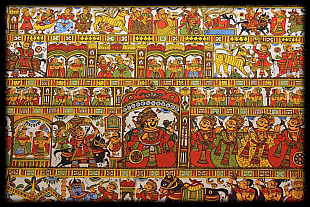
Madhubani Painting:
Madhubani Paintings is a very famous Indian Art among other arts. Since this art form is mainly practiced in the Mithila region of Bihar and Nepal that is why it is known as Madhubani or Mithila Art. This painting mostly has a complex geometrical structure and patterns in it. These paintings are widely known for ritual content for each festival and religious rituals they depict. Colors are derived from plants and other natural resources for Madhubani paintings.
The colors used often are bright and pigment like lampblack and ochre are used to make black and brown colors. In Madhubani paintings, twigs, matchsticks, and fingers are used to create the paintings instead of brushes. These paintings are done on freshly plastered or mud walls. Traditionally these paintings are done by women of the area but today men also do this work.
Some famous Madhubani painting artists are as follows- Sita Devi, Ganga Devi, Mahasundari Devi, Bharti Dayal, Jagdamba Devi, and many more.
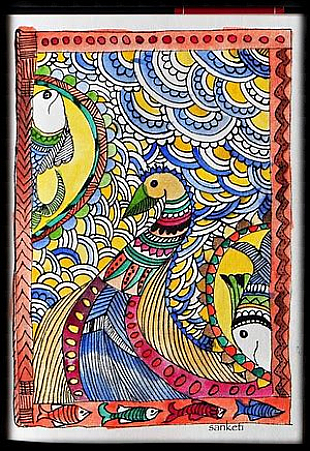
Warli Folk Painting
The Warli Painting art comes from Maharashtra. This Painting is done by the Warli Tribe. These tribes are found in the mountains as well as coastal regions of Maharashtra and Gujarat Border and their surroundings. Warli painting artist mainly uses the concepts of Mother Nature and elements of nature in their paintings. The Warli paintings are made in a white over brown background.
The White Colour used in these paintings is made from rice mixed water and gum, and ochre shades are achieved due to cow-dung plastered walls. These walls painting mainly have basic geometric shapes such as a circle, a triangle, and a square. These shapes are the symbolic representation of the Sun & Moon, Mountains & Conical trees, and Human Inventions respectively.
. The common scenes used in these paintings are hunting, fishing, farming, festivals, dance, animals, and trees
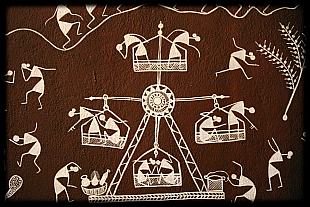
Tanjore or Thanjavur Painting
Tanjore artwork is mainly done in Thanjavur or Tanjore in the Tamil Nadu state of India, these paintings are mainly depicting Religious paintings with a Royal Heritage. Tanjore Paintings are among the world’s greatest traditional art forms for this India is known worldwide. The Theme of Tanjore Paintings is always based on the Mythological Hindu God, Goddesses, and Saints.
There are very few art forms that have the potential to match the grace and beauty of Tanjore paintings. Tanjore Paintings are made with rich and vivid colors, simple but iconic composition, shining gold foils work and these paintings also have glass beads and precious or semi-precious gems. Tanjore Paintings are made on wooden planks.
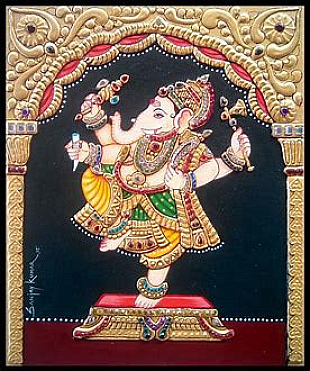
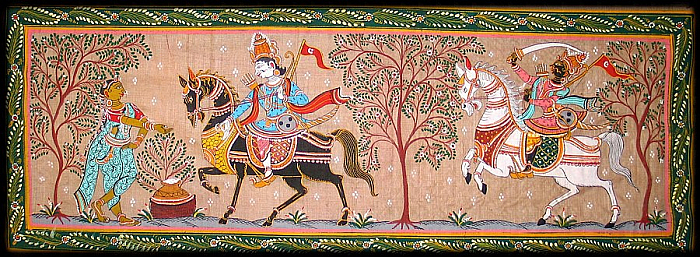
Pattachitra Paintings
Pattachitra Artwork comes from the land of Odisha and some part of West Bengal; this artwork is a cloth-based scroll painting. Pattachitra word came from Sanskrit, Patta means Canvas and Chitra means picture. So, these paintings are mainly done on Canvas. Some of the famous themes represented by this art form are Thia Badhia, Krishna Lila, Dasabatara Patti, and Panchmukhi. Preparing for the painting takes a very high level of concentration and very careful craftsmanship, Preparation for Patta (Canvas) alone takes around 5 days’ time.
Painters use vegetable and mineral colors to paint Pattachitra. White Colour is prepared from Conch-Shells, Red Colour is prepared from Hingula, Haritala for Black, Ramaraja for Indigo, Black color is prepared from burning coconut shells. Brushes used by Painters are made from the hair of domestic animals and bamboo sticks.
Kalamezhuthu Paintings
Kalamezhuthu Drawing art form is said to be a blend of Aryan, Dravidian, and Tribal traditions. Kalamezhuthu art comes from “God's own Country” in Kerala. This is a ritualistic and essential art that is mainly practiced in Temples and sacred groves of Kerala. In every drawing or artwork, there are patterns, details, dimensions, and color chare chosen with strict rules. These drawings are done with natural pigments or powders.
Generally, these drawing are made using five colors and with bare hands without using any other tool. The colors used are rice powder for white, burnt husk for black, turmeric for yellow, a mixture of lime & turmeric for red, and leaves of certain trees for green color are used.
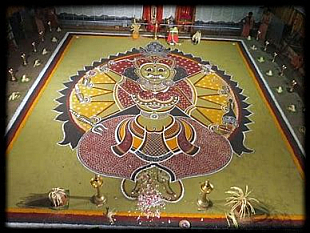
Gond Art
Gond Art comes from Madhya Pradesh and is made by Gondi Tribe. This artwork is mainly based on Nature’s flora and fauna. These paintings are made by using bold and vibrant colors.
The colors used to make these paintings come from charcoal, cow dung, leaves, and colored soil. Gond paintings are created from dots and lines. In today’s world, these paintings are made by the use of Acrylic Colours.

Kalamkari
Kalamkari means drawing with a pen. Broadly two types of Kalamkari Drawing Art are present in India:
- Machilipatnam Kalamkari - This Kalamkari art form is originated from Machilipatnam, Andhra Pradesh. This art form is mainly based on a block-printed form of art.
- Srikalahasti Kalamkari -This Kalamkari art form is originated from Chitoor, Andhra Pradesh. This art form is mainly based on free-flowing art with a pen on the fabric.
Kalamkari is mainly based on the themes of Ramayana or Mahabharata. But in recent times Kalamkari is also used to make musical instruments, small animals, flowers, Buddha, and Swastika, etc.

folk art India folk and tribal art of India contemporary art of India easy folk art of India folk art of India drawing different folk art of India folk art of different states of India types of Indian folk art
Comments